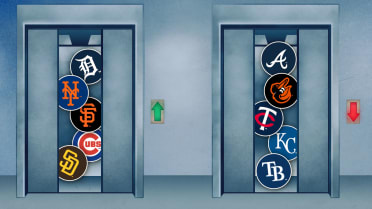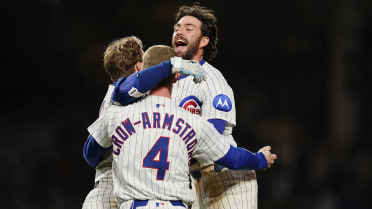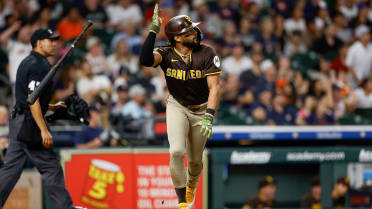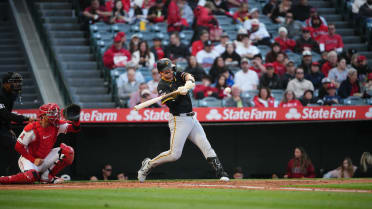The Yankees are 60 games into the 2021 season, which in normal times might be the “is it too early to worry or not” point, but in these very not-normal times, we remind you that if this were last year, the season would be over. They’d have ended the season in fourth place. They’d have the lowest runs per game for a Yankees team since 1972, also a fourth-place team from an era Bronx Bombers fans prefer to ignore.
Some of that is simply a reflection of what’s going on across the sport, as the ever-increasing strikeout rate and general dearth of contact and production continue to be an ever-present concern. The Yankees are not alone in terms of lineup production problems. But they are alone in terms of just how deeply they’ve underperformed, in terms of comparing FanGraphs’ preseason runs-per-game projections to what has actually happened.
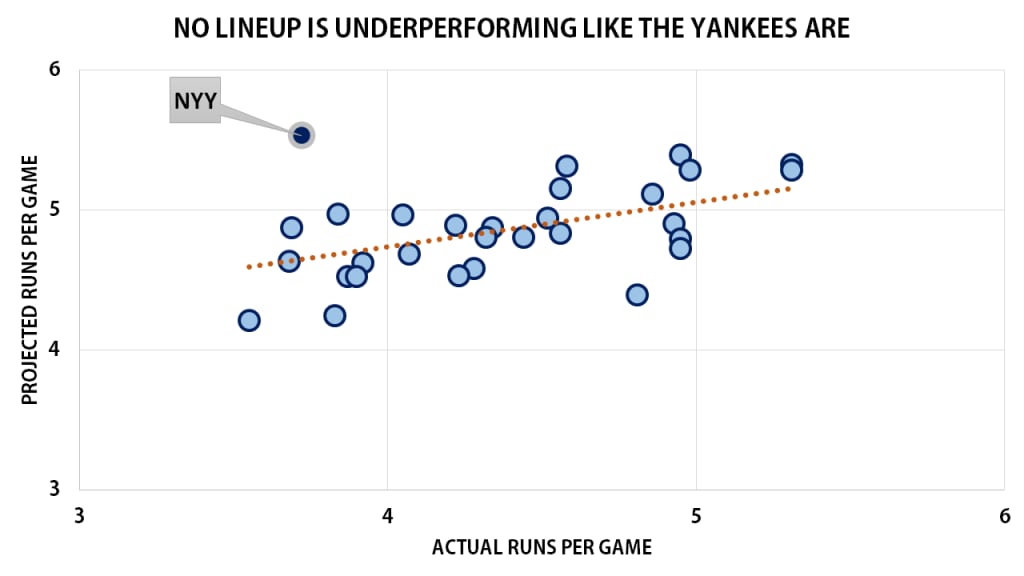
The Yankees are one of just three teams to underperform projections by more than one run per game. They’re down by nearly two runs per game, as their average of 3.72 is lagging that 5.53 projection by a full 1.81 runs. They have the sixth-lowest slugging percentage in the game; they have scored the sixth-fewest runs in the game. These are supposed to be the Yankees.
But … why? DJ LeMahieu was one of the 10 best hitters in baseball from 2019-20. He didn’t suddenly forget how to hit. Clint Frazier’s issues had long been about health, defense and opportunity, seemingly culminating in what looked like a 2019-20 breakout. That’s all come undone. This is the case, mostly up and down the lineup.
It’s not strikeouts, not really. Ten teams have struck out as much as or more than the Yankees, among them the Rays, arguably baseball’s best team, and the Giants, baseball’s biggest surprise team. (The celebrated 1927 Yankees struck out a ton by the standards of the time, anyway.) It’s not an overreliance on the “three true outcomes” of strikeouts, walks and homers, because while the Yankees do those things the fifth-most often, the top three teams (Rays, Giants, Brewers) would all be in the playoffs if the season ended today.
It’s not injuries, mostly. Sure, they’ve had their share -- Luke Voit and Aaron Hicks most prominently -- but to date, the Yankees have missed out on just over 5% of their projected preseason Wins Above Replacement, less than 16 other teams. It’s not platoon splits; they’ve performed equally against lefties and righties.
It’s not that they don’t walk enough (they’re second best, actually). It’s not that they don’t hit the ball hard enough (third best, actually). It’s not that they chase too much (fifth lowest, actually, behind four excellent teams). It’s not that they haven’t been “clutch,” because they’re middle of the pack. It’s not that they don’t swing enough at first-pitch strikes, as they do so almost exactly at an average rate.
It is that they’ve done a poor job of scoring the runners they put on -- worst in baseball at that, importantly -- and while that’s obviously bad, that’s a bit more about describing what has happened than predicting what will happen. That might be a little about the fact that no team has had more runners thrown out on the bases (28, most in baseball) and no team has taken a lower rate of extra bases (30%, lowest in baseball). This is not a good baserunning team, not that it was ever expected to be.
Still, since a lot of those underlying indicators -- good hard-hit rate, good plate decisions, high walk rate -- are strong, this feels like less of a team-wide approach issue than it does a collection of underperforming players. (Most of them, anyway. Aaron Judge has been outstanding.) Given that the pitching has also been outstanding, the lineup is responsible for almost all of the 2021 team’s struggles.
So, let’s take a look at the 10 Yankees batters who have come to the plate the most, in descending order of plate appearances, and find their One Big Number, the key reason they’re not performing, or are. It might help us figure out if any of this is fixable. The top 10 doesn't show us that, due to Voit's absence, Yankees first basemen have been baseball's weakest, and it doesn't point out that Tyler Wade is a backup infielder who doesn't possess a Major League bat. But among the 10 who have stepped to the plate the most, this is what we're seeing.
1) DJ LeMahieu: -67 points of BABIP / +8.2 points of K%
OK, fine, Two Big Numbers.
As great as LeMahieu was in 2020, there were some warning signs under the surface. His ground-ball rate, which had been 50% from 2018-19, went up to 57%. His barrel rate -- barrels being the perfect combination of exit velocity and launch angle -- had dropped from 7.5% to 2.9%, in the bottom 10% of hitters. (It is identical this year.) He was, based on Statcast’s expected outcome metrics, the biggest overperformer in the game last year. Given that he played just 50 games, it’s quite unlikely he’d have kept up that 1.011 OPS all season.
So, some kind of a step back was likely. But this? This is something else. No currently active hitter has fallen off more. The problem is two things, really. First, he’s swinging and missing in the zone twice as much as he did last year, doubling his strike rate. So he’s making less contact, and then even though the quality of his contact is similar to 2020, he’s getting less out of it, which was totally predictable.
It’s easy to see him improving the contact rate a bit. It’s easy to see him improving on one of the weakest home slugging percentages by a Yankee in the last quarter-century. (No, really. That list is full of backup infielders and final gasps from former All-Stars.) That outsize production on contact isn’t coming back, though. It never was.
2) Aaron Judge: No. 1 overall in quality of contact
Hey, it can’t all be bad news. That same Statcast quality-of-contact metric we just noted above? Even if you include the strikeouts and walks, Judge is currently No. 1 among all qualified hitters in that metric. (Unsurprisingly, he’s also the best in baseball if you’re looking only at when he makes contact.) He’s cut his strikeout rate while maintaining his elite hard-hit skills; he’s a quality enough defender that he’s been covering some time in center field.
If not for Shohei Ohtani and Vladimir Guerrero Jr., we’d be talking about Judge as an AL MVP candidate. The Yankees have a lot of problems, but Judge is not one of them.
3) Gleyber Torres: 5-point improvement in K%
For all the talk about whether Torres could handle the defensive demands of shortstop -- it’s been, charitably, choppy -- there was always an assumption that the Yankees would look past it so long as he hit. But last year: .724 OPS, 102 OPS+. This year: .715 OPS, 104 OPS+. Last year he had eight doubles and three homers, and this year he has eight doubles and three homers. He is, at least over the last 120 Yankees games, consistent.
That is, of course, a terrible disappointment to anyone who saw him post a 125 OPS+ in 1,088 plate appearances at ages 21 and 22 in 2018 and ‘19. Even in the moment, it seemed clear that 2019 was fluky -- he’s not a 38-homer profile, and that was the year the Majors broke the all-time home run record -- but allow us to blow your mind, briefly.
From 2018-19, Torres had a 125 OPS+. He struck out 23% of the time and chased out of the zone 30% of the time.
From 2020-21, he’s got a 103 OPS+. He’s struck out 18% of the time and chased out of the zone 21% of the time.
He was better when making less contact. He’s become much less aggressive on the first two pitches of a plate appearance. You wouldn’t want to say a batter should strike out more, but ... has Torres sacrificed that good contact for the sake of more contact?
4) Gio Urshela: +11 points of strikeout rate
Let’s start with the good news: Urshela is making good contact. His hard-hit rate is the highest of his three years with the Yankees. When he hits the ball hard, his ground-ball rate on those hard-hit balls is the lowest of his three years with the Yankees. When he makes contact, he’s making the highest quality of contact he’s made since he arrived in the Bronx.
Why, then, has his breakout 2019 OPS+ of 132 and his 2020 OPS+ of 136 collapsed into this year’s just-OK 106 OPS+? Because that “when he makes contact” part above is doing a great deal of work; Urshela is essentially tied with Kyle Seager for the largest jump in strikeout rate from 2020. Why? We know he’s been hampered by a knee issue, so that can’t be helping. Interestingly, however, Urshela is swinging through fastballs more while being more productive against them, and he's swinging through breaking balls less while being less productive against them.
5) Clint Frazier: -10 points of line-drive rate
It’s not just hitting, for the record. Frazier’s fielding has gone from terrible (2019) to quite good (2020) to back near the bottom (2021). He’s even running more slowly this year. But we’re here for hitting, so let’s stick to hitting. Frazier (78 OPS+) is striking out precisely as much as he has the last two years. He’s actually walking twice as much as he did in 2019. Almost no one chases less than Frazier; he’s on a list with some true superstars. His hard-hit rate is down, but only a little. What’s wrong?
It’s this. It’s that Frazier is hitting more grounders (up from 41% to 45%) and also more popups (15 already this year; he had 15 total from 2018-20). It’s that between hitting more balls up and down and fewer in the nitro zone where they actually matter, his production has gone with it. Just look at the top three hitters in terms of biggest line-drive rate drops from last year; you have Yasmani Grandal, who is having a bizarrely successful season despite hitting .153, and Francisco Lindor, who has been a disappointment all around.
The harder part is the why. It's not terribly clear what is driving this. There's still promise here.
6) Giancarlo Stanton: 65%
That’s “percent of Yankees games where Stanton is in the starting lineup,” which, if you want to be particularly cheery about it, is much higher than last year’s 38% or 2019’s 11%. That, really, is what it always comes down to.
It's another thing, too. It's also his hard-hit rate, which, even by his monumental standards, is obscenely hard. A 65% hard-hit rate is wild, the highest on record. And sure, he's hitting it on the ground too much, and he's striking out at a rate that is higher than fans want but not out of line with today’s power hitters, and he's wildly streaky; Stanton had an .882 OPS before a May 13 quad injury, and he’s got two hits (both singles) and four walks in 28 plate appearances since.
But with LeMahieu down and out, Stanton is the second-best hitter on this team. When, that is, he’s in the lineup.
7) Gary Sánchez: .271 BABIP
Seemingly forever a lightning rod to the Yankees fanbase, Sánchez has, at the least, been better than last year’s wretched .147/.253/.365 line, which got him benched in October. There are a few reasons behind what tanked his 2020 season so badly, but the one that stands out to us is that his .178 BABIP -- that’s batting average without strikeouts and homers, the ones fielders can actually catch -- was literally one of the worst of all time. That’s about speed, about contact, about predictability, but also about something that’s difficult to do once and all but impossible to do again.
He’s not. His .271 BABIP this year is a little better than his career average and only a tick below the Major League average. The hits are falling in a way they didn’t last year, and he’s basically been a league-average (103 OPS+) hitter. That’s not enough, obviously. The 29% strikeout rate is too high, the power too inconsistent. Sánchez is not the solution to the problems. But unlike last year, he’s not the primary cause of them, either.
8) Brett Gardner: 26% strikeout rate
There’s a particular kind of player for whom you’re willing to live with strikeouts, and usually that’s the Judge/Stanton type of massive power slugger, where you take the whiffs knowing that when contact is made, it’s incredibly valuable. Gardner, 38 in August, is not that type of hitter, and that’s a problem when his strikeout rate has crept up each year since 2018. He’s now whiffing more than Judge.
Needless to say, he does not offer the power that Judge does. Not that he was ever an elite power hitter, of course, but his hard-hit rate is now in the 17th percentile. When he makes contact, it hasn’t been particularly valuable -- it's among the weakest in the Majors. He’s probably been asked to play more than he ought to given Hicks' absence, but “less contact” + “less valuable contact” is a tough pairing to overcome.
9) Aaron Hicks: 592 plate appearances
Hicks had a strong season in 2018, taking 581 plate appearances with good defense and a 127 OPS+, earning a seven-year contract extension the next winter. But his 2019 was ruined by back and elbow injuries, and he’s now likely out for the remainder of 2021 following left wrist surgery. While his season line looks poor (78 OPS+), he was starting to heat up before the latest injury, with a .962 OPS over his final 10 games. The injury robbed the Yankees not only of a likely productive hitter (he had a 120 OPS+ from 2017-20), but also caused -- and is still causing -- a center-field scramble.
The 592 plate appearances, for what it’s worth, are what he’s taken over the first three years of his seven-year extension.
10) Rougned Odor: -71 points of slugging
In April, the Rangers cut loose their longtime second baseman because they’d tired of the low average/low on-base/sometimes power style Odor had brought. The Yankees traded for him in part to free up LeMahieu to cover first base, and while Odor has had some big hits, his .180/.266/.342 line is almost exactly what he did in Texas the last two years, except with less power. He’s clearly selling out to try to hook balls into the right-field porch -- his 54% pull percentage is a career high, by a lot -- and so when that works, as it has five times, that’s great.
But at what cost? When it doesn’t work, on the 106 plate plate appearances where he hasn’t homered, walked or been hit by a pitch, he’s slugging .170. Now, obviously, every player looks worse when you take away their homers. But even for Odor, that’s considerably down from his Texas prime. So instead of the low average/low on-base/sometimes power he used to have, he’s now those things without the power, and is that the best use of this roster spot?
Ultimately, Voit will be back. Surely some kind of move for a desperately needed left-handed hitter, preferably one who can play center field, will be made. But in the tough AL East, it might not be about who gets added. It's about who's here. If LeMahieu, Frazier and Torres don't figure out a way to turn it around, none of the rest of it might matter. These are the 2021 Yankees ... for better or worse.
Mike Petriello is a stats analyst for MLB.com, focusing on Statcast and Baseball Savant, and is also a contributor to MLB Network.

